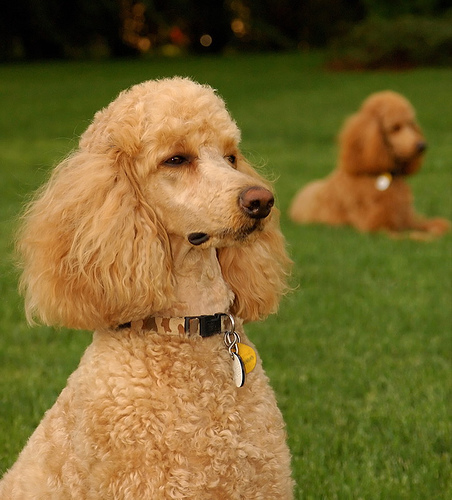In this article we will explore five basic issues that dog handlers or trainers must understand before they can hope for any success in dog training.
The very the first of these issues is that dogs are unable to reason. Arguably this is also the most difficult thing about dogs for a human being to understand and accept. We ourselves are continually reasoning things out; it is second nature to us. But try, if you will, to imagine that you cannot reason. You can see; you can hear; you can smell; you can feel; you can taste. But you cannot reason. All you can do is respond to stimuli. Just try it. Try really hard to understand such a condition. Picture yourself looking out into the world but being unable to reason. Don't think; just respond. Weird, isn't it?
Or let's take an example: assume that you are chained up with a collar around your neck, and food is placed on the floor just out of the reach of your hands. Assume further that if you cannot reach that food you will die of starvation. You would very quickly work out that you could reach the food with your feet and drag it to within reach of your hands. Try that with a dog. The dog will die without ever looking like reasoning out a solution to that problem. He will strain against the chain, reaching out with his front paws, but he will never ever turn around and try to scratch the food back towards him with his hind legs.
A real difficulty arises from this situation in that a dog is a very intelligent creature and when a human being who is able to reason is confronted with a dog that is unable to solve a very simple problem, that human being is likely to assume that the dog is either being disobedient or is just plain dumb. But in fact, it is the human being who is being dumb. Dogs are unable to reason. You just have to get that.
The second most important thing to understand about dogs is that they cannot understand words as such; they can only understand sounds. This can very easily be demonstrated by training a dog to come to you on the command 'go away' and to sit on the command 'stand', which can very easily be done. So remember this; a dog simply cannot understand words and so we must be very careful to always use the same word (preferably of one syllable) for each command and to try very hard to make sure the sounds are as dissimilar as possible.
Another critical matter is that a dog needs a leader. Remember again that the dog cannot reason and is therefore made comfortable when the reasoning is done for him/her. Without a leader in whom it has trust, a dog can lose confidence and become frightened and unpredictable. It may also feel comfortable by assuming the leadership role. This situation arises a lot with people/dog relationships where the person refuses to be, or cannot become the leader. So the trainer/handler has to become the leader that the dog needs.
A dog also needs love. In fact it would not be unreasonable to say that a dog craves love. Fortunately a dog will return your love tenfold, so loving the animal is not usually a difficult thing to do. Not difficult -- but absolutely critical.
Lastly a dog needs discipline. Their mother; and often other adult dogs, you will notice, often discipline puppies, so it is perfectly natural for the dog to be exposed to discipline. Without discipline, because the dog cannot reason, it loses direction and confidence and can become fearful and lose direction. The discipline must not be harsh or physical. It simply needs to be firm guidance as to what is okay and what is not okay.
So if you will remember these five critical points:
1. A dog cannot reason
2. A dog cannot understand words, only sounds
3. A dog needs a leader
4. A dog needs love and
5. A dog needs discipline
you will be the more than three quarters of the way towards being a good dog handler/trainer.

 Dehydrated Raw Dog Food Puts the Wag in Your Pets Tail
The Case for Dehydrated Raw
Dehydrated Raw Dog Food Puts the Wag in Your Pets Tail
The Case for Dehydrated Raw
 Where Can I Find a Dog for My Family?
Animal Shelter in Iowa, Washington
Cr
Where Can I Find a Dog for My Family?
Animal Shelter in Iowa, Washington
Cr
 Hypoallergenic Dogs List - The Best Dog Breeds For People With Allergies Or Asthma
Dogs For People With Allergies Or Asthma
Whenever I
Hypoallergenic Dogs List - The Best Dog Breeds For People With Allergies Or Asthma
Dogs For People With Allergies Or Asthma
Whenever I
 Designer Doggy Wear
Pampered PoochesWeve all seen them right? Little doggie
Designer Doggy Wear
Pampered PoochesWeve all seen them right? Little doggie
 How To Select And Fit A Prong Collar
A prong collar looks like a
How To Select And Fit A Prong Collar
A prong collar looks like a